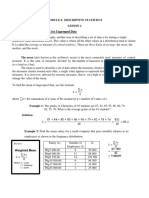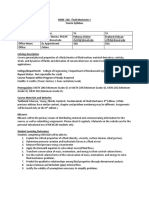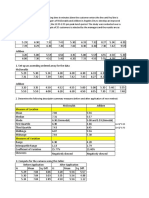0 ratings0% found this document useful (0 votes)
Example 5
Example 5
Uploaded by
Deval PatelThe president of a large company is deciding whether to implement a lunchtime exercise program to improve employee health and reduce medical expenses. Medical expenses were recorded for 12 months before and after an exercise program was introduced in one office. The data shows lower average monthly medical expenses after the program. A statistical t-test found the difference in mean expenses before and after to be statistically significant, indicating exercise programs reduce medical expenses. The mean monthly savings was estimated to be $3,083 with 95% confidence.
Copyright:
© All Rights Reserved
Available Formats
Download as XLSX, PDF, TXT or read online from Scribd
Download as xlsx, pdf, or txt
Example 5
Example 5
Uploaded by
Deval Patel0 ratings0% found this document useful (0 votes)
The president of a large company is deciding whether to implement a lunchtime exercise program to improve employee health and reduce medical expenses. Medical expenses were recorded for 12 months before and after an exercise program was introduced in one office. The data shows lower average monthly medical expenses after the program. A statistical t-test found the difference in mean expenses before and after to be statistically significant, indicating exercise programs reduce medical expenses. The mean monthly savings was estimated to be $3,083 with 95% confidence.
Copyright
© © All Rights Reserved
Available Formats
XLSX, PDF, TXT or read online from Scribd
Share this document
Did you find this document useful?
Is this content inappropriate?
The president of a large company is deciding whether to implement a lunchtime exercise program to improve employee health and reduce medical expenses. Medical expenses were recorded for 12 months before and after an exercise program was introduced in one office. The data shows lower average monthly medical expenses after the program. A statistical t-test found the difference in mean expenses before and after to be statistically significant, indicating exercise programs reduce medical expenses. The mean monthly savings was estimated to be $3,083 with 95% confidence.
Copyright:
© All Rights Reserved
Available Formats
Download as XLSX, PDF, TXT or read online from Scribd
Download as xlsx, pdf, or txt
0 ratings0% found this document useful (0 votes)
Example 5
Example 5
Uploaded by
Deval PatelThe president of a large company is deciding whether to implement a lunchtime exercise program to improve employee health and reduce medical expenses. Medical expenses were recorded for 12 months before and after an exercise program was introduced in one office. The data shows lower average monthly medical expenses after the program. A statistical t-test found the difference in mean expenses before and after to be statistically significant, indicating exercise programs reduce medical expenses. The mean monthly savings was estimated to be $3,083 with 95% confidence.
Copyright:
© All Rights Reserved
Available Formats
Download as XLSX, PDF, TXT or read online from Scribd
Download as xlsx, pdf, or txt
You are on page 1/ 2
Month Before After The president of a large company is in
Jan 68 59 the process of deciding whether to adopt a lunchtime
Feb 44 42 exercise program. The purpose of such programs
Mar 30 20 is to improve the health of workers and, in
Apr 58 62 so doing, reduce medical expenses. To get more
May 35 25 information, he instituted an exercise program for
Jun 33 30 the employees in one office. The president knows
Jul 52 56 that during the winter months medical expenses
Aug 69 62 are relatively high because of the incidence of colds
Sep 23 25 and flu. Consequently, he decides to record medical
Oct 69 75 expenses for the 12 months before the program and
Nov 48 40 for 12 months after the program. The “before” and “after”
Dec 30 26 expenses (in thousands of dollars) are compared on
a month-to-month basis and shown here.
a. Do the data indicate that exercise programs
reduce medical expenses? (Test with α = .05.)
b. Estimate with 95% confidence the mean savings
produced by exercise programs.
Month Before After Difference H0
Jan 68 59 9 Ha
Feb 44 42 2
Mar 30 20 10
Apr 58 62 -4 Right tail test
May 35 25 10
Jun 33 30 3 Significance level
Jul 52 56 -4
Aug 69 62 7 Critical value
Sep 23 25 -2
Oct 69 75 -6 Mean sample difference
Nov 48 40 8 Standard deviation of differences
Dec 30 26 4 Sample size
test statistic
Reject the H0
Expenses were high before and the exercise pro
mu d <= 0
mu d > 0
0.05
1.795885
3.083333
5.884623
12
1.815066
before and the exercise program was benificial
You might also like
- Cheat Sheet Interpreting Regressions Three PagesNo ratings yetCheat Sheet Interpreting Regressions Three Pages3 pages
- Rod C. Carter, CCP, PSP: ONG NternationalNo ratings yetRod C. Carter, CCP, PSP: ONG Nternational11 pages
- Instructions: A. Do All Calculation by Hand and All Working Steps Shown Are Given Marks. Repeat Each QuestionNo ratings yetInstructions: A. Do All Calculation by Hand and All Working Steps Shown Are Given Marks. Repeat Each Question3 pages
- UTS On Line Reg B Kls 05smjm003 Ruang OL - 426 smtrGENAP20212022 AkmenNo ratings yetUTS On Line Reg B Kls 05smjm003 Ruang OL - 426 smtrGENAP20212022 Akmen1 page
- Faculty of Business and Management: Assignment/ Project Declaration FormNo ratings yetFaculty of Business and Management: Assignment/ Project Declaration Form8 pages
- Long Intl A Reasonable Method To Estimate LoP Due To OT100% (1)Long Intl A Reasonable Method To Estimate LoP Due To OT11 pages
- Assignment 2024 - Instructions and question (3)[1]No ratings yetAssignment 2024 - Instructions and question (3)[1]11 pages
- A Project Report ON: "Inventory Control & Store Management" INNo ratings yetA Project Report ON: "Inventory Control & Store Management" IN16 pages
- Cluster University of Jammu (Established by Govt. of J&K) CBCS Exam Scheme Marks-Cum-Grade-SheetNo ratings yetCluster University of Jammu (Established by Govt. of J&K) CBCS Exam Scheme Marks-Cum-Grade-Sheet2 pages
- De La Salle University - Dasmariñas: College of Science and Computer StudiesNo ratings yetDe La Salle University - Dasmariñas: College of Science and Computer Studies2 pages
- Group 1 Project Exercise 4.2 MatugasAngeloNo ratings yetGroup 1 Project Exercise 4.2 MatugasAngelo5 pages
- Direction: Read The Questions Very Carefully. Answer by Shading The Letter of Your Choice in Each ItemNo ratings yetDirection: Read The Questions Very Carefully. Answer by Shading The Letter of Your Choice in Each Item3 pages
- Statistical Measures and Estimations: MathematicsNo ratings yetStatistical Measures and Estimations: Mathematics3 pages
- Maths T Semester 3 Coursework StatisticsNo ratings yetMaths T Semester 3 Coursework Statistics23 pages
- SMK Bandar Tasik Selatan, 57000 Kuala Lumpur Tingkatan 3 Alkhindi Penentuan Gred Purata Sekolah Pt3 Tahun 2015 (Etr)No ratings yetSMK Bandar Tasik Selatan, 57000 Kuala Lumpur Tingkatan 3 Alkhindi Penentuan Gred Purata Sekolah Pt3 Tahun 2015 (Etr)12 pages
- Parthvi Viradia (191aib099) Mathematical Functions: StudentNo ratings yetParthvi Viradia (191aib099) Mathematical Functions: Student6 pages
- Orca Share Media1650417607305 6922353171990977390No ratings yetOrca Share Media1650417607305 692235317199097739023 pages
- Introduction to Statistics Through Resampling Methods and Microsoft Office ExcelFrom EverandIntroduction to Statistics Through Resampling Methods and Microsoft Office ExcelNo ratings yet
- Standard Deviation of X: Coefficient of Variation X Coefficient of Variation YNo ratings yetStandard Deviation of X: Coefficient of Variation X Coefficient of Variation Y4 pages
- Assignment of Multiple Linear RegressionsNo ratings yetAssignment of Multiple Linear Regressions9 pages
- IEM 4103 Quality Control & Reliability Analysis IEM 5103 Breakthrough Quality & ReliabilityNo ratings yetIEM 4103 Quality Control & Reliability Analysis IEM 5103 Breakthrough Quality & Reliability46 pages
- Course On Bayesian Methods in Environmental Valuation: Basics (Continued) : Models For Proportions and MeansNo ratings yetCourse On Bayesian Methods in Environmental Valuation: Basics (Continued) : Models For Proportions and Means34 pages
- The Use of The Lognormal Distribution in Analyzing Incomes: Jakub NedvědNo ratings yetThe Use of The Lognormal Distribution in Analyzing Incomes: Jakub Nedvěd13 pages
- Test Bank for Stats Data and Models 5th by De Veaux PDF Download Full Book with All ChaptersNo ratings yetTest Bank for Stats Data and Models 5th by De Veaux PDF Download Full Book with All Chapters45 pages
- Unit Task - Introduction To Statistical Inference and Summary of The Different Basic Statistical Tests (I)No ratings yetUnit Task - Introduction To Statistical Inference and Summary of The Different Basic Statistical Tests (I)3 pages

























































































